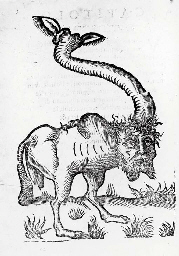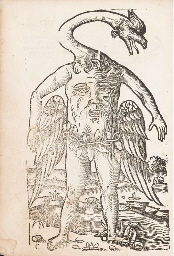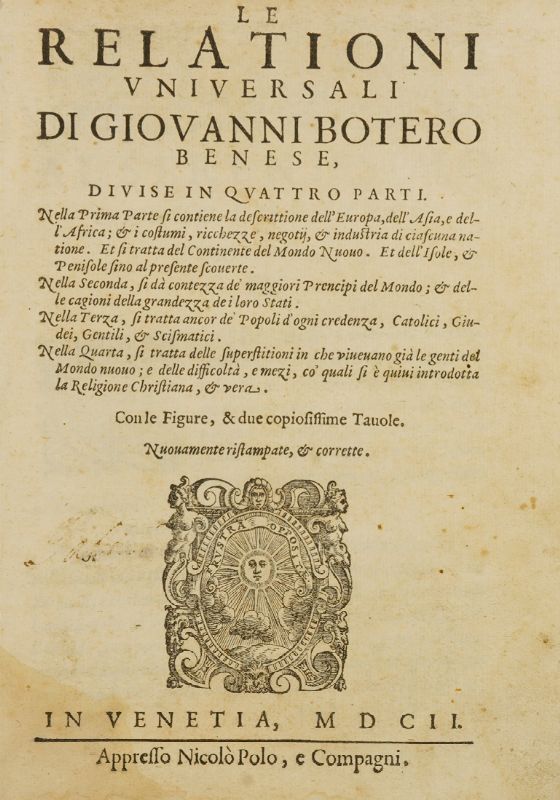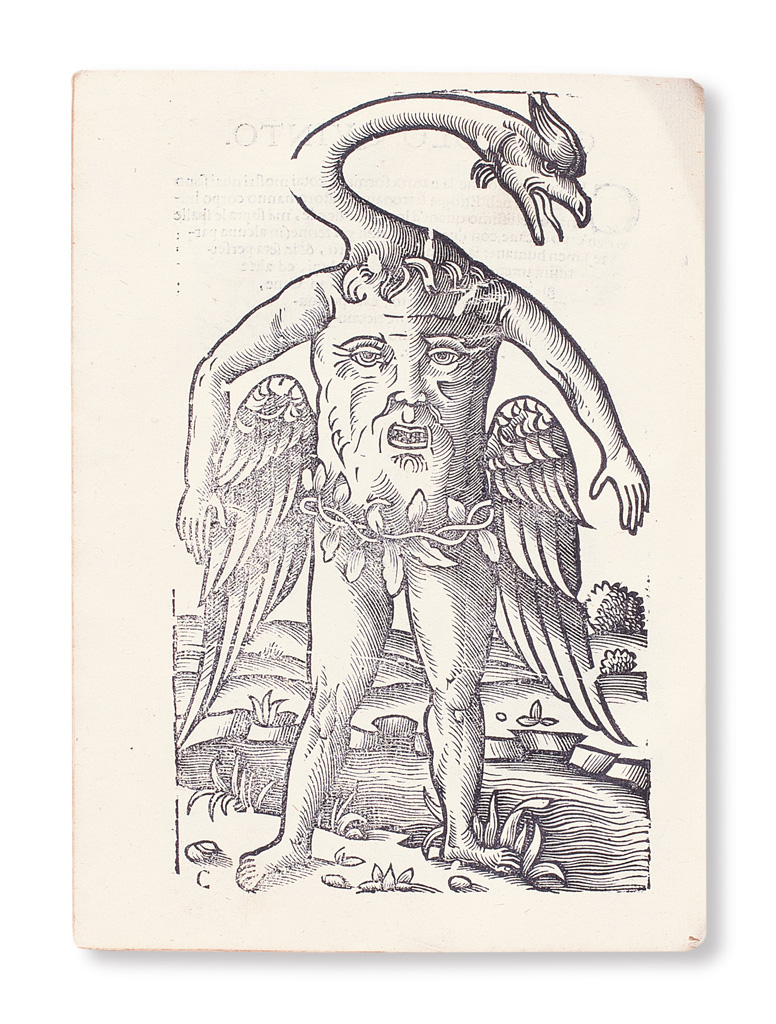BOTERO, Giovanni (1533-1617). Le Relationi Universali, divise in sette parti. ... Inoltre vi s'aggiunge nell'ultimo un breve racconte di Mostri, & Usanze de quelle Indie, con le sue Figure al naturale d'Alessandro de Vecchi . Venice: Alessandro Vecchi, 1617-18. 8 parts in one volume, 4° (215 x 150mm). 4 folding engraved maps of Europe, America, Asia and Africa, and 32 woodcuts, 30 full-page and 2 half-page, by Hans Burgkmair and his shop, one of two author portraits on each title, one repeated as frontispiece in part VI, ornamental head- and tailpieces and initials. (Occasional light dampstain, repaired neat tear in maps, short tear in one woodcut, another woodcut just shaved, small marginal tears in first two leaves discreetly repaired.) 18th-century mottled calf-backed marbled paper boards, gilt ornament in spine compartments, later spine label. Provenance : MS correction on III: E8v. FIRST EDITION WITH THE AGGIUNTA , CONTAINING 32 REMARKABLE WOODCUTS BY HANS BURGKMAIR AND HIS WORKSHOP. Walter Oakeshott has masterfully reconstructed an important woodcut work by the great Augsburg artist Hans Burgkmair and his workshop by showing that 17 of these woodcuts are part of a large frieze dated 1508 depicting a procession of the King of Cochin and showing natives of Guinea, east Africa and India, which was carved up into individual blocks for use in book form for the present edition. Copies of the 1508 original are exceedingly rare, with only one portion of the print known to survive; the five woodcuts which are carved from one block of east African and Indian natives are the earliest surviving impressions of that illustration. Despite its rare survival, Burgkmair's woodcut frieze was clearly known in the first part of the 16th century, as attested by books illustrated with cuts influenced by them. The 15 other woodcuts, which Oakeshott assigns to the circle of Burgkmair, illustrate fantastical creatures inhabiting the far corners of the world. One of these is reputed to live in the province of Santa Cruz and is therefore an early representation of life in the New World. Oakeshott has further argued that the woodcuts were intended to illustrate the account by Balthasar Springer of Vils of a voyage from Portugal to Africa and the East Indies under Francisco d'Almeida in 1505-6, even though no illustrated edition of that work survives. One of the patrons of that expedition was the Welser family of Augsburg, who also patronised Burgkmair. The woodcuts have 'claims to be the first serious study of native life and dress made for publication in a European travel book' (Oakeshott, p.22). Botero's Relationi was considered the best geography for more than a century. It describes the Catholic world in far-flung places, and gives detailed accounts of exotic cities and countries. It includes a discussion of the New World: Florida, Mexico, and South America, particularly Brazil, Chile and Peru. Owing to the extensive statistical information provided here, Botero was considered by the economist MacCulloch to be a precursor of Malthus. Oakeshott, Some Woodcuts by Hans Burgkmair , Oxford: 1960; D. Lach, Asia in the Making of Europe , II, book I, Chicago: 1965-70, pp.80-81; Sabin 6806; Alden/Landis, European Americana , 618-20.
BOTERO, Giovanni (1533-1617). Le Relationi Universali, divise in sette parti. ... Inoltre vi s'aggiunge nell'ultimo un breve racconte di Mostri, & Usanze de quelle Indie, con le sue Figure al naturale d'Alessandro de Vecchi . Venice: Alessandro Vecchi, 1617-18. 8 parts in one volume, 4° (215 x 150mm). 4 folding engraved maps of Europe, America, Asia and Africa, and 32 woodcuts, 30 full-page and 2 half-page, by Hans Burgkmair and his shop, one of two author portraits on each title, one repeated as frontispiece in part VI, ornamental head- and tailpieces and initials. (Occasional light dampstain, repaired neat tear in maps, short tear in one woodcut, another woodcut just shaved, small marginal tears in first two leaves discreetly repaired.) 18th-century mottled calf-backed marbled paper boards, gilt ornament in spine compartments, later spine label. Provenance : MS correction on III: E8v. FIRST EDITION WITH THE AGGIUNTA , CONTAINING 32 REMARKABLE WOODCUTS BY HANS BURGKMAIR AND HIS WORKSHOP. Walter Oakeshott has masterfully reconstructed an important woodcut work by the great Augsburg artist Hans Burgkmair and his workshop by showing that 17 of these woodcuts are part of a large frieze dated 1508 depicting a procession of the King of Cochin and showing natives of Guinea, east Africa and India, which was carved up into individual blocks for use in book form for the present edition. Copies of the 1508 original are exceedingly rare, with only one portion of the print known to survive; the five woodcuts which are carved from one block of east African and Indian natives are the earliest surviving impressions of that illustration. Despite its rare survival, Burgkmair's woodcut frieze was clearly known in the first part of the 16th century, as attested by books illustrated with cuts influenced by them. The 15 other woodcuts, which Oakeshott assigns to the circle of Burgkmair, illustrate fantastical creatures inhabiting the far corners of the world. One of these is reputed to live in the province of Santa Cruz and is therefore an early representation of life in the New World. Oakeshott has further argued that the woodcuts were intended to illustrate the account by Balthasar Springer of Vils of a voyage from Portugal to Africa and the East Indies under Francisco d'Almeida in 1505-6, even though no illustrated edition of that work survives. One of the patrons of that expedition was the Welser family of Augsburg, who also patronised Burgkmair. The woodcuts have 'claims to be the first serious study of native life and dress made for publication in a European travel book' (Oakeshott, p.22). Botero's Relationi was considered the best geography for more than a century. It describes the Catholic world in far-flung places, and gives detailed accounts of exotic cities and countries. It includes a discussion of the New World: Florida, Mexico, and South America, particularly Brazil, Chile and Peru. Owing to the extensive statistical information provided here, Botero was considered by the economist MacCulloch to be a precursor of Malthus. Oakeshott, Some Woodcuts by Hans Burgkmair , Oxford: 1960; D. Lach, Asia in the Making of Europe , II, book I, Chicago: 1965-70, pp.80-81; Sabin 6806; Alden/Landis, European Americana , 618-20.














Try LotSearch and its premium features for 7 days - without any costs!
Be notified automatically about new items in upcoming auctions.
Create an alert